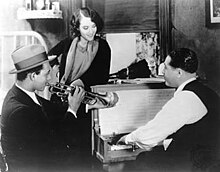Symphonies in Black: Duke Ellington Shorts
A programme by Jonathan Rosenbaum and Ehsan Khoshbakht (Il Cinema Ritrovato, Bologna, June 2024)
Introductory note by Jonathan Rosenbaum
In 16 shorts made over a stretch of almost a quarter of a century (1929-1953), Duke Ellington and his Orchestra perform in a variety of settings, often with dancers and singers – including Billie Holiday in Symphony in Black: A Rhapsody of Negro Life. The latter cuts freely between Ellington alone in thoughtful composing mode, Ellington in a tux performing the same extended composition with his band at a concert, arty images of men engaged in heavy labour, a wordless church sermon, a nightclub floorshow, and even a short stretch of story showing Holiday being pushed to the ground by an ungrateful lover before singing there about her misery – a near replica of the musical setup accorded to Bessie Smith in her only film appearance six years earlier.
Indeed, although the pleasures to be found here are chiefly musical, the narrative pretexts for these performances offer a fascinating look at how both jazz and Black musicians were perceived and expected to behave during the first three decades of talkies. At least half of the films are Soundies made for sound-and-image jukeboxes in the 40s, but even these often trade on narrative details such as the adoring women digging the solos by Ray Nance, Rex Stewart, Ben Webster, and others at an “eatery” after hours in Jam Session (1942), or the spectacular dancing by athletic jitterbugging couples in Hot Chocolate (Cottontail) from the same year.
Diverse forms of cinematic ingenuity are highlighted at the start and end of this programme. Black and Tan was directed by Dudley Murphy, who had collaborated with Fernand Léger on Ballet mécanique (1924), and adapts some of its images for the hallucinations of a dancer (Fredi Washington) with a weak heart; no less impressive is the film’s protest against racial exploitation rubbing shoulders with its comic racial stereotypes. The snazzy, inventive wipes in A Bundle of Blues (1933) are no less striking, as are the pulsing edits of Daybreak Express (1953), where D.A. Pennebaker, shooting in 16mm, celebrates, illustrates, and rides Manhattan’s long-vanished Third Avenue El to the strains of a rollicking Ellington tune.
This only begins to describe the diversity on view, which includes a George Pal Puppetoon (Date with Duke), an appearance by the Delta Rhythm Boys in Symphony in Swing, and an homage to Louis Armstrong that is exclusively visual in a three-minute “History of Jazz” in Salute to Duke Ellington.
Black and Tan
USA, 1929 Regia: Dudley Murphy
A Bundle of Blues
USA, 1933 Regia: Fred Waller
Symphony in Black
USA, 1935 Regia: Fred Waller
Jam Session
USA, 1942 Regia: Josef Berne
Hot Chocolate (“Cottontail”)
USA, 1942 Regia: Josef Berne
I Got It Bad & That Ain’t Good
USA, 1942 Regia: Josef Berne
Flamingo
USA, 1942 Regia: Josef Berne
Duke Ellington and His Orchestra
USA, 1943 Regia: Jay Bonafield
Date with Duke
USA, 1947 Regia: George Pal
Symphony in Swing
USA, 1949 Regia: Will Cowan
Salute to Duke Ellington
USA, 1950 Regia: Will Cowan
Caravan
USA, 1952 Regia: Duke Goldstone
Mood Indigo
USA, 1952 Regia: Duke Goldstone
Sophisticated Lady
USA, 1952 Regia: Duke Goldstone
Solitude
USA, 1952 Regia: Duke Goldstone
Daybreak Express
USA, 1953 Regia: D.A. Pennebaker

